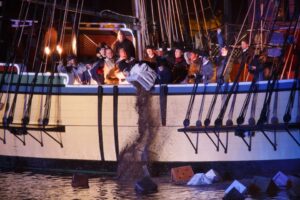250th Anniversary of the Boston Tea Party
 Photo courtesy of John Collins Photography
Photo courtesy of John Collins Photography
Boston Tea Party Video Resources:
Revolution 250 Podcast – TEA with James Fichter – https://youtube.com/live/BXQW3gG_oXs?feature=share
Revolution 250 Podcast – Polly Sumner & the Boston Tea Party – https://youtube.com/live/M8_qQGQ-dsE?feature=share
Revolution 250 Podcast – Relics of the Past with J.L. Bell – https://youtube.com/live/RW3K964gG84?feature=share
Revolution 250 Podcast – In Search of Tea Party Participants with Kristin Harris – https://youtube.com/live/r9pIysBVF08?feature=share
Revolution 250 Podcast – The Boston Tea Party with Evan O’Brien – https://youtube.com/live/HlxeUeQXI0U?feature=share
Professor Robert Allison – The Boston Tea Party – https://youtu.be/eNNlqn_YUCI?si=eX1OrVxGwOFCy3DE
History of the Boston Tea Party
A Timeline
April 27, 1773 – Parliament passes the Tea Act.
May 10, 1773 – The Tea Act receives the royal assent.
June 4, 1773 – Elisha Hutchinson, Thomas Hutchinson, Jr., Benjamin Faneuil, Jr., & Joshua Winslow chosen consignees for the shipment of tea.
September 27, 1773 – The first of seven ships laden with 544,000 pounds – nearly two-thousand chests – of East India Company Chinese black and green teas set sail from the port of London bound for four American cities. The Nancy was destined for New York, the Polly for Philadelphia, and the London for Charleston, South Carolina. Four ships, Eleanor, Dartmouth, Beaver and William, sailed toward the port of Boston.
October 5, 1773 – The William, bound for Boston, reported at Deal, UK.
November 3, 1773 – Gathering at the Liberty Tree to hear a public resignation of the Tea Consignees. 500 people attend, including John Adams, Samuel Adams, John Hancock & Joseph Warren. The consignees refuse to comply.
November 17, 1773 – a large number of people gather in School Street and damaged the home of Richard Clarke, one of the tea consignees.
November 18, 1773 – Another meeting is held at Faneuil Hall at which the consignees refuse to resign and they flee to Castle William
November 28, 1773 – The Dartmouth arrives with the first of the tea. She carries 114 chests of tea. Under the laws of Customs, the town of Boston has 20 days from this day to unload the tea. Dartmouth also carries other cargo, including the first edition of Phillis Wheatley’s Poems on Various Subjects, Religious and Moral. Phillis was an enslaved person from Africa who had been brought to Boston as a young girl and raised up in Wheatley family.
December 1, 1773 – The Eleanor, Captain James Bruce, arrives with 114 more chests of tea.
December 7, 1773 – The Beaver, Captain Hezekiah Coffin, arrives in Boston harbor with a case of smallpox onboard. The ship is quarantined at Rainsford Island, cleared of cargo and smoked with suphur.
December 8, 1773 – Governor Hutchinson stations vessels at the entrance to the harbor to prevent the ships from leaving without permission.
December 10, 1773 – The Brig William runs aground on Cape Cod. In her are 114 chests of tea, the first 310 street lamps for Boston
December 12, 1773 – Lexington, Massachusetts – The citizens of Lexington “had unanimously resolved against the use of Bohea tea of all sorts, Dutch or English importation,” and gathered all the tea they could in town and burned it in public.
December 13, 1773 – Burning of the Tea at “Tea Rock” in Marshfield
December 14, 1773 – Another meeting at the Old South Meeting house at which Francis Rotch is ordered to seek clearance for his ships to sail back to England with the tea. The meeting is adjourned to December 16.
December 15, 1773 – The ship Beaver is brought up to Griffin’s wharf. A courier from the Plymouth Committee of Correspondence writes to Samuel Adams about the wreck of the Brig William. Sam Adams replies, urging action and also writes the Sandwich Committee of Correspondence.
December 16, 1773 – 5,000 people attend a meeting at the Old South Meeting House and Rotch delivers Governor Hutchinson’s answer. 6 p.m. – the meeting breaks up and a crowd heads to the wharf.
December 16, 1773 – Jonathan Clarke sails for Cape Cod to save the cargo – pays laborers to remove the tea to Provincetown and from there hired a fishing vessel to bring it to Castle Island.
December 17, 1773 – Committee of Correspondence sends Paul Revere with a report of the events to New York & Philadelphia
December 26, 1773 – Two vessels arrived at Boston with the news that the William was seen burning on Saturday the 25th of December 1773.
December 28, 1773 – 1,000 people gather in Charlestown to burn in the public Market Square all the tea they could find at high Noon. Also, tea that was found in the house of Mr. Withington of Dorchester was burnt on Boston Common.
January 17, 1774 – Tea burned and destroyed in Newburyport, MA.
January 20, 1774 – committee of Correspondence hold a bonfire on King Street and burn 700 pounds of tea. 3,000 miles away, John Hancock’s ship, Hayley, reaches London with the news of the Boston Tea Party. Merchants in Boston commit to abandon the selling of all teas.
January 22, 1774 – First reports of the Boston Tea Party published in London Newspapers.
March 8, 1774 – The ship Fortune arrives in Boston with 28 chests of tea which is dumped into Boston harbor.
March 17, 1774 -William Lamson (of Martha’s Vineyard) came to Lyme with 100 lbs. of tea on horseback saved out of the William. The people of Lyme started a fire and committed the tea to the flames.
March 25, 1774 – Parliament passes the Boston Port Act
May 10, 1774 – News of the Boston Port Act reaches Boston in the ship The Harmony, Capt. Shayler.
May 13, 1774 – General Thomas Gage arrives as the new governor of Massachusetts Bay and closes the port of Boston.
May 31, 1774 – The last day ships are allowed to sail from Boston harbor, Thomas Hutchinson and his family sail for England.
October 4, 1774 – Confiscated Tea burned in Salem, MA
November 4, 1774 – 4 to 500 pounds of tea burned in Charlestown, MA.
Events
for the
250th Anniversary
of the
Boston Tea Party
